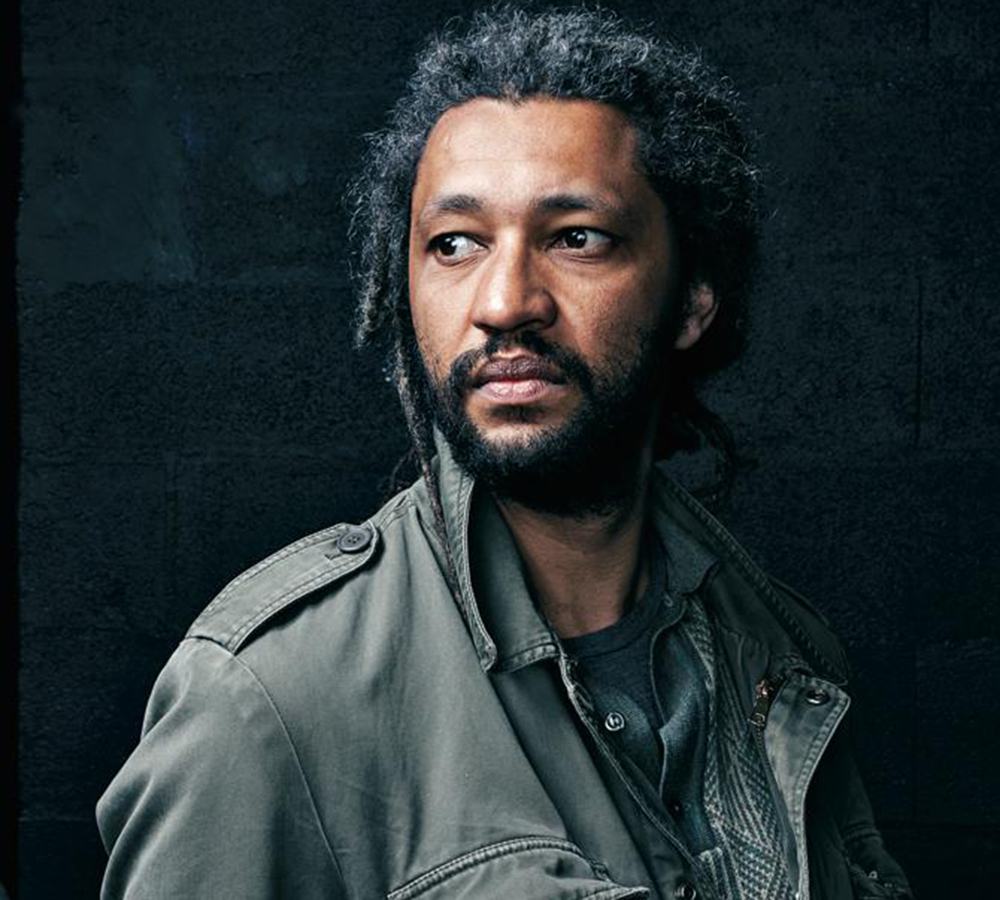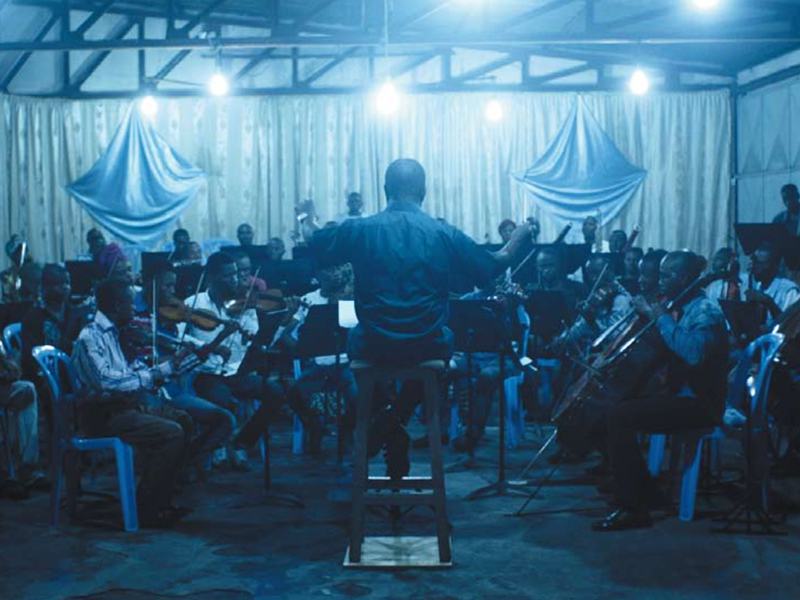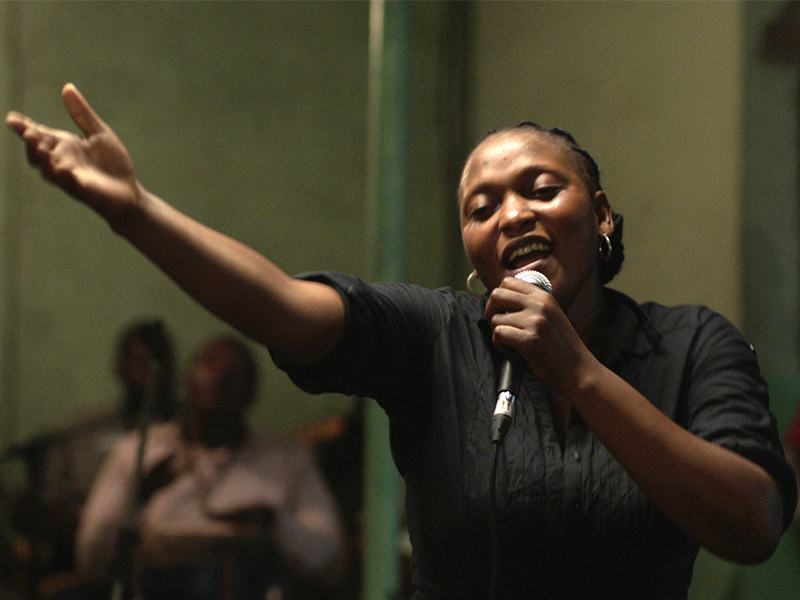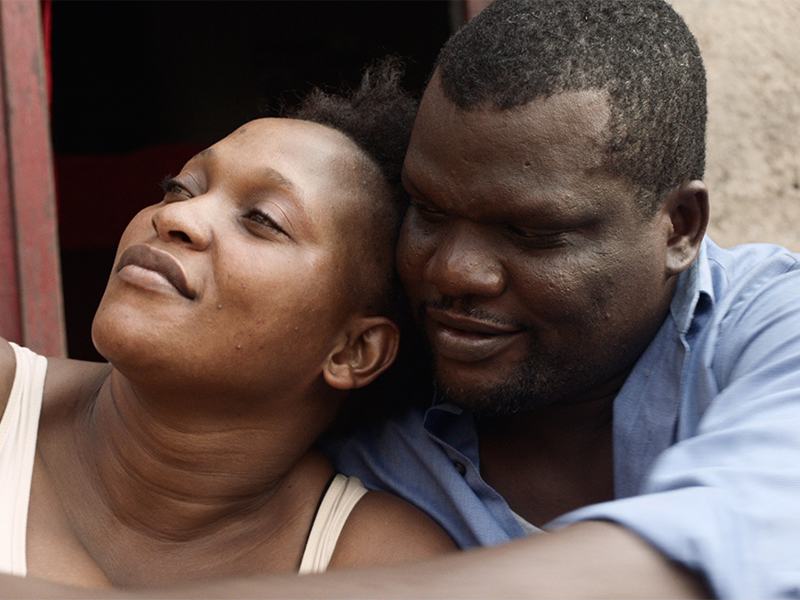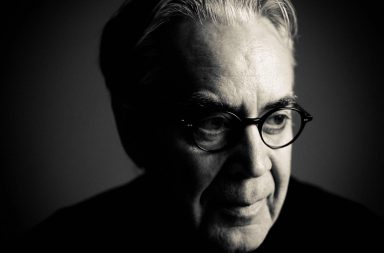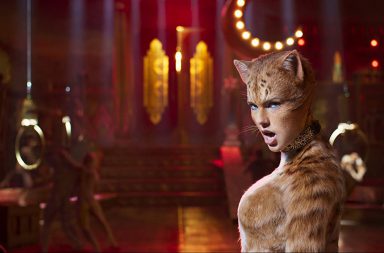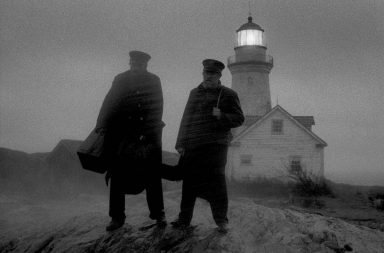Félicité is a film that is both raw and profoundly poetic, oscillating between dream and reality. The film’s alternation between music by Kasai Allstars and Arvo Pärt (played by the Kimbanguiste Orchestra, based in Kinshasa, Democratic Republic of Congo) is present throughout the entire film with a mesmerizing effect.
Alain Gomis is a French director of Bissau-Guinean and Senegalese origin. Born in France in 1972, Gomis started directing short films in the late 1990s, such as the critically acclaimed Whirlwinds (1999) and A Little Light (2003). In 2002, L’Afrance, his first feature film, won the Silver Leopard in Locarno. In 2013, his third film with Saul Williams, Tey (Today), won the Golden Stallion at Fespaco (Pan African Film Festival), the first Senegalese film to do so.
Steadily gaining more and more attention but always faithful to his own style, Gomis’s fourth feature film Félicité was released in France in March 2017. The film tells the story of Félicité, a strong and proud woman who sings at a Kinshasa bar every evening, in the Democratic Republic of Congo. Félicité’s life is thrown chaotically off-track when her 14-year-old son, Sapo, is the victim of a motorbike accident, and she must rapidly find the financial means to fund his urgent hospital operation. Balancing on the boundary between resistance and renunciation, Alain Gomis tries to depict life as he sees it, whilst highlighting beautiful and proud human beings.
The film was awarded a Silver Bear Grand Jury Prize at the 2017 Berlinale and a Golden Stallion at the 25th Fespaco Festival. We had the honour of discussing with director Alain Gomis his musical choices for the film, his influences and his vision when directing live music scenes.
Score It: Was the music in Félicité always such an important part of the film, even at the very beginning of the project?
Alain Gomis: Ever since the start, the idea was always to create a piece of work which focused on a female protagonist. Later on, while I was watching a video online, I realised that I wanted the film to be about a singer. There isn’t usually a lot of music in my films, whereas listening to music is one of my main activities. So, I was delighted to be able to make a film about music and especially about live music. Then, a little later came Arvo Pärt’s orchestra. The film actually became more and more musical over time.
You have stated that Nina Simone’s music, especially her iconic track ‘Ain’t Got No’, gave rhythm to the film’s writing process. Can you tell us more about this influence?
I write a lot whilst listening to music. Indeed, this track came about during the film’s writing process, when I was thinking about Félicité (the main character) and also during the filmmaking process. Before meeting the Kinshasa Kimbanguist Orchestra, I was listening to ‘Orgie and Bess’ quite a lot (the Miles Davis and Gil Evans version). I got the idea to use different music from elsewhere that would describe the story of Félicité in a different way.
During those creative wanderings, I came across this song by Nina Simone that I didn’t know before. It reassured me a little about the nature of the film, as I then realized that Blues music could do some good, and also the track gave a sort of justification to what unfolds between the three main characters of the film. It was a bit like Nina Simone was approving my choices! (Laughs)
The classical music in the film, composed by Estonian musician Arvo Pärt and played by the Kimbanguist Symphony Orchestra, creates a striking contrast both with the tumult of the capital city Kinshasa and also with the protagonist’s own music. Why did you opt to include this contemporary classical music in the film? Why did you choose the composer Arvo Pärt in particular?
To tell you the truth, it was a rather organic choice. I was listening to a radio show one day and I discovered the track ‘Fratres’ that was playing in the background. I went on the show’s website, found out that it was a piece composed by Arvo Pärt and I started to listen to it a lot whilst writing at the same time.
When I met the Symphony Orchestra, their repertoire was much more classical in genre, with pieces by Haydn for example. I immediately wanted to work with them because they could bring a sort of detachment to the film. This orchestra could be represented as the ‘heart’, offering a distance that would allow the film to transcend the social tragedy, thus allowing us to see the characters as normal people: a woman, a man and a child.
Furthermore, I wanted these two groups to both play music from the same contemporary era. Kasai Allstars produce a sound which makes the bowels of the earth resound, while Arvo Pärt’s music is much more celestial. This creates a loop of dialogue between the two different kinds of music, which works very well together.
I was surprised, as Arvo Pärt’s music is almost ‘amelodic’ (at times with no clear tune and with dissonant chords) in layers, with a strong capacity for introspection. Despite the fact that this music seems simple, it is actually very difficult to play because the music is always on the brink of dissonance (with a lack of harmony). For an amateur orchestra, these out-of-tune notes are tough to achieve. Not only did they accept this challenge, but they have reclaimed the music by truly re-orchestrating it.
They accomplished this interesting aspect of the music perfectly. I don’t mean this in technical terms, but they grasped the fundamental aspect of what the music was about. The orchestra had an interpretative force that I found incredible. Therefore, that side of the film was done rather naturally, but the original idea was that these two groups’ music was from an identical timeframe.
The intensity of the classical music in Félicité progresses throughout the length of the film. What role does it play in the narrative?
At first, this music poses a kind of drama with an almost tragic tone. With ‘Fratres’, notably, the music gives the film a sense of being close to the mythological. Then, the track ‘My Heart In The Island’ is precisely in the spirit of where Félicité is at that moment, in the sense that it’s a profoundly melancholic song about bidding farewell to one’s homeland. At that precise moment, the way we filmed the orchestra shows that something very fragile and uncertain is setting into the plot. The soprano starts to sing, and we can’t figure out how that is going to evolve.
Frankly, it is both a surprising and sincere scene that accepts the confidence that we entrust in it. In a sense, we feel a bit stupid having doubted these musicians. Consequently, we allow ourselves to be swept more into the story from that moment onwards. Finally, we trust these characters; we listen to them attentively and we are taken by a certain sincerity that make us feel closer to them.
The opera singer is extraordinary. Yet, even though the final image didn’t turn out to be the best shot of her, that was actually the best compromise between her voice and the image onscreen at the time. Then the choir comes in, symbolising a form of reconciliation. The choir is an entity in itself, and we also tried to individually show the singers who make up this body, as if each of them could be a Félicité, a Tabu or a Sapo in their own right.
As the film progresses, the orchestra becomes more and more prominent, finally becoming a large part of the film by the end.
In addition to classical orchestral music, you have decided to include opera music in the film, sung by African musicians. Why did you choose this additional music genre in the film’s score?
Whilst listening to Arvo Pärt, I was really seized by its choral aspect and I like vocal music in general. Thus, concluding Félicité with not just one single voice but with a chorus was evident in highlighting the broader idea that this film speaks of a ‘we’ and a ‘together’. Besides, there was something simple yet incredibly powerful in this track which logically brought it to becoming the film’s final touch.
Many scenes take place in a Kinshasa bar, where Félicité’s band plays. The film’s striking opening scene directly immerses you into this electric and explosive atmosphere, bringing a strong realism to the film. How did you manage to direct these live music scenes and preserve this spontaneous feel? What do you think are the major challenges while filming live music?
We decided to shoot the bar music scenes in two different ways, filming it live and then with a playback version. The playback version came either directly from an existing album or pre-recorded as new tracks. Meanwhile, we always shot in continuity in order to preserve the musicians’ and audience’s live energy, even if it meant replaying the same songs ten times in a row.
We filmed with the regular customers who usually come to the bar. They were a normal group who were used to talking, and at times allowed themselves get caught up and carried away by this cyclical music. Therefore, we sometimes had to wait for those true moments when the audience got up and started to dance, coming closer to the singer. The idea was to transcribe how people usually feel in this kind of environment, whilst being as understated as possible.
I find it really difficult to film live music because it often doesn’t work on screen. When I listen to music, personally I don’t know where I am; I’m elsewhere: in the forest, perhaps (Laughs)! Thus, I try to film the sensation and that focuses almost more on the audience than on the actual musicians who are playing.
With singers being the exception, most musicians’ facial expressions are not always very interesting because their art is something truly interior. That’s why we did a lot of close-ups, and why we also concentrated more on what was happening around the musicians. In the end, the editing side of the filmmaking process was when we really tried to express the audience’s emotions to counterbalance the music. For example, we tried not to let the image follow the tempo when the music speeds up. Instead, we tried to become even more in-depth as the music intensifies, which is going almost the opposite way to how the music is progressing, actually.
As you have mentioned elsewhere, Kasai Allstars composed songs especially for the film. Where did their inspiration for writing these tracks come from? How did you work with them?
I asked them to get me to listen to tracks which had never been recorded. And since Kasai Allstars actually comprises of five different music groups, each group sent me their own compositions for me to listen to. For the most mystical and seductive composition, the idea was that the song directly came from the animals, as if they themselves were the ones singing.
When I was in Kinshasa with Kasai Allstars, I picked three or four of these unreleased tracks. Then, while writing the film back in Paris, I tried to figure out where these tracks would fit without any sense of repetition, in order that they would follow the progression of the audience’s emotions.
The original soundtrack album, Around Félicité, comes with a bonus disc which consists of 10 remixes created by various artists from the electronic music scene such as Clap! Clap!, Daedelus and Africaine 808. This bonus disc is a part of the broader project “Around Félicité”, a multimedia platform which invites creatives to express their other artistic visions of the film through remixes, photography exhibitions and live-music events. How did you come up with the idea of mixing African and electronic music together with Crammed Disc Records?
For me, Kasai Allstars’ musical sound is both rock and electronic yet in a traditional sense, through their way of electrifying their instruments. Asking people coming from the electronic music scene to make remixes was first out of curiosity to find out how they were able to understand this music. We also wanted to share the result on a larger scale, with people who may be familiar with electronic music but not necessarily this kind of African music in particular, or with Kasai Allstars’ music.
I love this music so much that I want to share it with as many people as possible, helping the greater public find out about these new sounds, getting them to realize how modern this music actually is. This is a creative territory where artists can meet each other and exchange ideas. Here, as equals, they can bring their own cultural roots and artistic styles to the table, in order to create something together. I really like the idea that this project continues to function even now, and that its roots can give fruition to other great pieces of work.
When it comes to the artistic direction of the project Around Félicité, it was first managed by Saul Williams and then by Mathias, a member of the French music community Fumisteries. Mathias was the one who went around looking for artists in a completely open-minded way.
More broadly speaking, the story of the film Félicité is told through the eyes of other artists. Where did this original concept come from?
That was an idea that was present from the very beginning. My writing process is inspired by the music that features in the film and also outside of the film. When writing, I’m also inspired by visual artists, writers and photographers. Therefore, I wanted to pay homage to them by exposing their work to a wider audience that may not be necessarily familiar with it.
Besides, when we promote a film, we tend to focus more inwardly on ourselves. But, I find it much more interesting if the film is a living object and brought elsewhere, which might simultaneously spark new pieces of work. This idea of ‘mixing’ is really crucial to me, in order to avoid stagnation and a ‘dead’ project.
“Alain Gomis’ projects are journeys before becoming objects”, Jacques Denis stated whilst he presented Autour de Félicité. Could you tell us about the direction of your future journey(s)?
They’re materialising slowly, but a film really does take up three or four years of your life. What matters at the end is not the two hours of the film, but the journey getting there: those past four years. It’s a bit like the film’s analogy of the fridge; it didn’t matter that it wasn’t completely fixed in the end, because if Tabu was better at repairing then there would have been no love story.
It’s a long journey. I think the hardest thing at first is to find that large space where you’ll spend four years of your life, knowing that it’s rich enough to be able to feed you creatively and watch you grow during that period. The main challenge is to come up with something that ages for you; your film may reach the screen as a dead project that doesn’t exist anymore.
For now, the next creative space is too large for me to be able to specify what it will precisely consist of. I think music will again have an important place, as I still feel that I have a lot to explore in that field. One thing is for certain: it will be related to the diaspora (a large group of people with a similar heritage and homeland who have since dispersed all over the world) concerning the ‘black world’ in a greater sense, not necessarily in Africa.
Interview prepared, conducted, transcribed, translated and edited by Amalia Morris and Sylvain Pinot.
Edited by Marine Wong Kwok Chuen.

